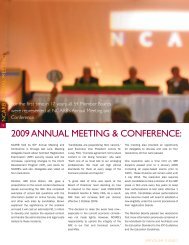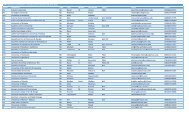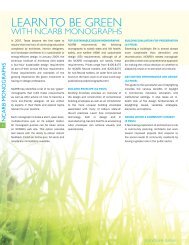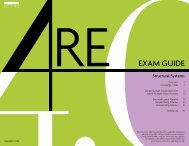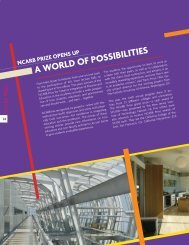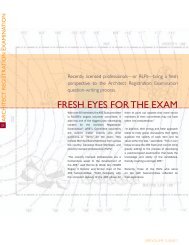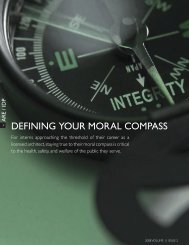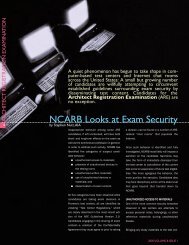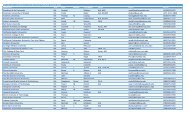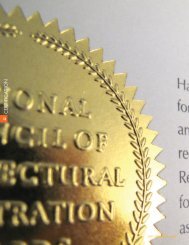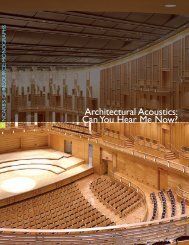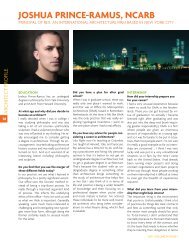Model Brief to Enforce Laws Prohibiting Architectural ... - NCARB
Model Brief to Enforce Laws Prohibiting Architectural ... - NCARB
Model Brief to Enforce Laws Prohibiting Architectural ... - NCARB
You also want an ePaper? Increase the reach of your titles
YUMPU automatically turns print PDFs into web optimized ePapers that Google loves.
<strong>Model</strong> <strong>Brief</strong><br />
Medak v. Cox, 12 Cal. App. 3d 70, 90 Cal. Rptr. 452 (1970) (denying recovery<br />
by clients of fees paid <strong>to</strong> unlicensed architect because services performed fit within<br />
statu<strong>to</strong>ry exemption from definition of architectural services, and because clients<br />
knew that architect was unlicensed when they entered in<strong>to</strong> contract) (construing Cal.<br />
Bus. & Prof. Code § 5537, regarding exemption for single-family dwellings).<br />
Walter M. Ballard Corp. v. Dougherty, 106 Cal. App. 2d 35, 234 P.2d 745, 749<br />
(1951) (fee recovery case) (corporation could recover fees for doing preliminary<br />
sketches for client, because corporation was <strong>to</strong> hire licensed architect <strong>to</strong> make final<br />
and detailed working plans, and because preliminary sketches were not within the<br />
statu<strong>to</strong>ry definition of architectural services) (construing Cal. Bus. & Prof. Code §§<br />
5536 and 5537, which exempt from licensing requirement individuals who inform<br />
clients that they are not licensed before they perform services).<br />
District of Columbia<br />
Dunn v. Finlayson, 104 A. 2d 830, 832 (D.C. Mun. Ct. App. 1954) (fee recovery<br />
case) (holding that statute does not include construction administration within the<br />
meaning of the practice of architecture; also noting that previously, only the unlicensed<br />
use of the title “architect” was unlawful) (construing D.C. Code § 2-1014(b)<br />
(1951), defining the practice of architecture as “rendering or offering <strong>to</strong> render<br />
services by consultations, preliminary studies, drawings, specifications, or any other<br />
service in connection with the design of any building . . .”).<br />
Florida<br />
Alfred Karram, III, Inc. v. Can<strong>to</strong>r, 19 Fla. L. Weekly D666, 634 So.2d 210 (1994)<br />
(fee recovery case) (Florida architect-licensing statute does not require licensure for<br />
preparation of plans and specifications for one-family or two-family residences)<br />
(construing Fla. Stat. §§ 481.219, 481.229).<br />
Rolls v. Bliss & Nyitray, Inc., 408 So.2d 229, 235-37 (Fla. App. 1981), appeal<br />
dismissed, 415 So.2d 1359 (1982) (fee recovery case) (Florida architect-licensing<br />
statute does not constitute a bar <strong>to</strong> recovery under contract where one of the architects<br />
is not licensed in Florida, if the services are rendered in connection with the<br />
design of a building <strong>to</strong> be constructed outside the borders of that state) (construing<br />
Fla. Stat. § 467.17 (1977), proscribing practice of architecture by unlicensed<br />
persons “in this state”).<br />
Georgia<br />
Georgia State Bd. for Examination, Qualification and Registration of Architects v.<br />
Arnold, 249 Ga. 593, 594-96, 292 S.E.2d 830, 831-33 (1982) (subcontrac<strong>to</strong>r who<br />
erected the metal walls and roof of a warehouse in accordance with technical drawings<br />
prepared by a licensed engineer did not engage in the practice of architecture<br />
within the meaning of the Georgia architect-licensing statute because these services<br />
were the services of a specialty subcontrac<strong>to</strong>r, not an architect, and were done in<br />
accordance with drawings prepared by a licensed engineer) (applying Ga. Stat. Ann.<br />
§§ 84-301 and 84-321).<br />
Georgia State Bd. for Examination, Qualification and Registration of Architects<br />
v. Bush, 249 Ga. 593, 594-96, 292 S.E.2d 830, 832-33 (1982) (individual who<br />
prepared drawings for his employer for buildings that the employer intended <strong>to</strong> sell<br />
and lease <strong>to</strong> others did not engage in unlicensed practice of architecture, but qualified<br />
for statu<strong>to</strong>ry exemption because his services were purely “in-house” as they were<br />
24



